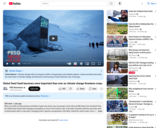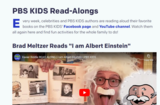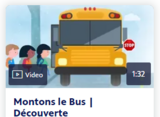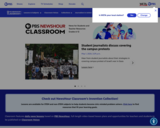
Some great ideas in here!
- Subject:
- Education
- Material Type:
- Teaching/Learning Strategy
- Author:
- PBS
- Date Added:
- 02/12/2019

Some great ideas in here!

As the environmental, economic, and political consequences of climate change are felt in Alaska, the Arctic, and throughout the world, we have much to learn from both the traditional knowledge of Native peoples and ongoing scientific research. These two methods of observing nature and solving the challenges of survival can provide complementary perspectives on these issues. This collection looks at Alaska’s unique geology and the impact of development and climate change using both of these tools, and features Alaska Native scientists who are working toward solutions.
Collections to explore:
- Traditional Way of Knowing (spirit, air, fire, water, earth)
- Earth as a System (atmosphere, biosphere, cryosphere, hydrosphere, lithosphere)
The site includes the ability to switch to student view, which will take you to many other PBS Learning resources.

DNA. It's what makes you unique. Unless you have an identical twin, your DNA is different from that of every other person in the world. And that's what makes DNA fingerprinting possible. Experts can use DNA fingerprints for everything from determining a biological mother or father to identifying the suspect of a crime. What, then, is a DNA fingerprint and how is it made? Here, you'll find out by solving a mystery—a crime of sorts. First, you'll create a DNA fingerprint (we'll supply the lab and all necessary materials). Then you'll compare this DNA fingerprint to those of all seven suspects to nab the perpetrator. Ready? Let's get to work!

This site offers opportunities to watch interesting videos, design cool things, build neat stuff and play awesome games.

Digital Nation is a new, open source PBS project that explores what it means to be human in an entirely new world -- a digital world. It consists of this Web site as well as a major FRONTLINE documentary to be broadcast on Feb. 2, 2010. Our production team is posting rough cuts and raw footage on the web, and gathering input, feedback and stories from users as we go.

A PBS Learning Media resource that is perfect for pre-K kids. Topics from math, science to art provide early childhood resources to strengthen kids’ interest and sense of discovery.

When you think of fresh produce and fields of grain, the Arctic may not spring to mind. But just 800 miles from the North Pole, the Global Seed Vault holds emergency stockpiles of most of the world's crops. It provides scientists with the tools they need to breed plants able to cope with a changing world.
This video explores the Global Seed Vault and its uses, especially with the threat of climate change for crops.

As ballparks fill up around the country, Jeffrey Brown looks at a new exhibit on the long history of Latinos playing baseball and how they changed the sport fundamentally in the U.S.

As climate chaos increases around the world, Michelle Week, a farmer outside of Portland Oregon is drawing on her Sinixt indigenous knowledge to adapt her farm to the changing seasons. By practicing techniques like seed saving and dry farming, Michelle is combating the increasing food security crisis while continuing to provide fresh food to her local community.
Women of the Earth is a new show on PBS Terra, produced by Summer Moon Productions, featuring stories of women across America who are leading a new movement to restore and protect the land. By focusing on women in land stewardship roles like farmers and shepherds, the series will explore women’s unique relationship to the earth and their innovative undertakings to heal the earth from climate change.

This site offers online science, mastered: exceptional content within meaningful tasks.
Labs include: Exoplanet, Polar, Evolution, Cyber Security, RNA, Cloud, Energy, Sun
Free. For grades 6-12

Find fun online games for kids featuring PBS KIDS characters. Students can find printables, coloring pages, online games and more.

"Every week, celebrities and PBS KIDS authors are reading aloud their favorite books."
There are some fabulous books here!

Discover the French language and culture through a variety of resources aimed at students of all ages. World Languages - French includes the Learning French collection that aims to make bilingual education easy for parents, students, and educators. French culture is also examined through the eyes of a street artist specializing in recreating classical works. Resources include interactive lessons, videos, audio clips, and more.

Explore the many forms of visual art, from basket weaving to painting, and glasswork to furniture, with resources that encourage analysis, research, and practice. Preschoolers can practice their colors and discover how colors change when mixed with a lesson from the Abracadabra series. Middle and high school students can design self-logos and write descriptions of them after watching "The Art of Logo Design" from Off Book. The Math + Arts collection provides cross-curricular lessons that combine math with visual arts topics such as Shapes & Patterns, Perspective Drawing, and Totem Poles. Filmmaking, photography, and architecture, in addition to careers in art, the history of visual arts, and art institution, are all also explored.
Explore the videos, interactive lessons, interactives, lesson plans, galleries, audio files, images, documents, webpages and collections. Lots to offer!

This site offers math videos for students in the following areas:
Counting and Cardinality
Operations & Algebraic Thinking
Number & Operations in Base Ten
Geometry
Measurement & Data
Number & Operations—Fractions
Ratios & Proportional Systems
Statistics & Probability
The Number System
Expressions & Equations
Functions

"PBS NewsHour Extra's lesson plans are outstanding and clever. For example, a lesson on unions asks students to watch a few short videos and then get into teams to resolve an imaginary labor dispute based on what they've learned about negotiation. Beyond the provided lesson plans, there are many videos with resources to help students process what they're watching -- like an essential question and key vocabulary -- as well as discussion questions to kick off post-viewing conversations. Plus, the majority of the lesson plans are tied to STEM-related issues, so they're ideal for cross-curricular collaboration.
Because the daily videos include transcripts, supporting links, questions, and an extension activity, they could be assigned as independent work, group work, or both. For instance, part of the class could work on their own with the video -- assuming individual internet access -- and then, as they finish, they could move into small groups to tackle the extension activity.
For journalism, media studies, or ELA classes, make sure to check out the Student Voices samples. They'd serve as great models for editorial writing. For classrooms that want do dive deeper into media creation and production, the Student Reporting Labs website has a great curriculum and supporting resources, including video tutorials for things like audio recording and lighting." (Review from Common Sense Media)

The video shows how baseball and Central American culture has been intertwined throughout both of their histories. The video provides an overview of the development of Central American baseball and how that has evolved to be reflected in the current game.

Explore the past and learn about the present with resources on government, history, economics, and more with this vast library of videos, lessons, interactive lessons, galleries, audio clips, images, documents, webpages and collections.
Be sure to check out the hubs for other subjects too!!!!

Episode Three: Gaamiinigooyang – “That Which Is Given To Us” describes the traditional Ojibwe survival system through numerous interviews with historians, tribal leaders, and elders; combined with visually stunning dramatic sequences of the four seasons’ traditional economic cycle. Key interviews are powerfully illustrated with archival photographs, documents, maps, and historical film footage.
Travel from the times before contact, through the Fur Trade period, which introduced European concepts of personal profit, land ownership, and debt. This episode traces the damaging effects of treaties and land loss on the very survival of the Ojibwe; the economic reforms of the 1960s and 70’s self-determination; and contemporary court decisions which have re-affirmed reserved rights to practice traditional hunting, fishing, and gathering. Many of today’s Ojibwe people are experiencing a renewed economic sovereignty through new sources of financial stability including gaming, tribal businesses, and individual entrepreneurship.
..

Can you tell the difference between Ojibwe and Dakota beadwork? Stick with host Susan until the end of the video and you'll be able to notice the differences.
00:00 Can you spot the difference between Ojibwe & Dakota beadwork?
01:53 The history of beadwork in Native communities
02:28 Historical Dakota beadwork from the Minnesota area
03:24 Ojibwe floral designs and nature in Ojibwe art
04:42 The history of Indigenous beadwork in the Minnesota area
06:36 Extra: the Spirit bead
From the craft, to the textile, to finishing touches, and even to the customs that come with it, our traditional clothing reflects our cultural identity. Worn Within explores the stories and people behind our traditional clothing.